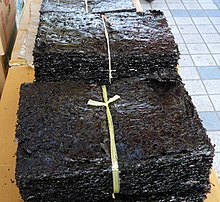Gim (food)
| Gim | |

gim
|
|
| Korean name | |
|---|---|
| Hangul | |
| Revised Romanization | gim+ |
| McCune–Reischauer | kim |
Gim (Korean pronunciation: [ɡiːm]; Korean: 김), also spelled as kim, is the Korean word for edible seaweed in the genus Porphyra. It is similar to nori, a Japanese word for this seaweed and used in the production of sushi in Japan. Porphyra is also called laver in English.
The earliest mention of gim is recorded in the Samguk Yusa (hangul:삼국유사, hanja:三國遺事) a document created during the Goryeo era documenting the history of the Three Kingdoms Period of Korean history covering 57 BCE to 668. The Samguk Yusa contains passages that record gim having been used as part of the dowry for Shilla royalty. It is conjectured, however, that gim of this period was harvested from rocks and driftwood rather than being cultivated.
From the mid-Joseon period there are records of gim in 15th century documents Gyeongsangdo Jiri Ji(hangul:경상도지리지, hanja: 慶尙道地理誌) and Sinjeung Dongguk Yeoji Seungnam (hangul:신증동국여지승람, hanja:新增東國輿地勝覽). Gim is recorded as a regional delicacy.
Many legends about the etymology of the word gim are given. One version explains that an old lady in the region of Hadong discovered a log covered in gim floating down the Seomjin River, which inspired her to cultivate it on upright bamboo support poles. Another legend says that the word "gim" was named after its creator, Kim Yeo-ik (김여익), who lived in the island Taeindo during the reign of King Injo, who was the first person to have cultivated gim after seeing a drifting oak branch covered in it. Although the true origins of the term are unclear, records dating from the 17th century of Kim Yeo-ik indicate cultivating gim. A monument in Taeindong, Gwangyang, is set up in his honor for these achievements.
...
Wikipedia
